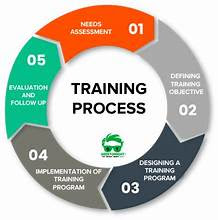Training & Development
TRAINING & DEVELOPMENT
TRAINING
To meet the industrial challenges and competition domestically and globally Organizations consider investing in training as a highly important organizational function. Therefore training plays an important part in developing employees by enhancing their knowledge, skills, and capabilities. while benefiting the employee's career development training contributes to the overall growth and success of the organisation immensely,
"Training Function " is a process of
- Planning
- Organizing
- Implementing
SETTING UP AND EFFECTIVE HR TRAINING ECOSYSTEM
To create a robust job training and development ecosystem an ongoing commitment, investment and collaboration among stakeholders to align with organizational goals and contribute to the growth and success of the organization is the most important requirement.
- Identifying Organizational Goals and Objectives.
- Assess current skills and knowledge
- Analyse existing training programmes
- Involving Key stakeholders in input and support for training and development initiatives
- creating a steering committee
- Specify clear learning objectives
- Align with business goals
- Create customized learning paths
- Personalise learning journeys
- Investing in learning platforms
- Explore emerging technologies
- Create a curated content
- Development of multimedia resources
- Offer multiple delivery options
- Defining KPIs (Key Performing Indicators) and Metrics
- Regularly assess progress
- Gather feedback
- Regularly assess impact
- Staying Updated
- Adopting continuous needs
- Encourage a culture of learning
- Recognise and reward learning achievements
- Communicate learning and development opportunities
- Encourage Participation
- Allocate Resources
TRAINING FUNCTIONS WITH MODERN TECHNOLOGY
- Virtual Reality (VR) & Augmented Reality (AR)
Virtual Reality (VR)
- Entertainment ( Video Games),
- Education (such as medical, safety, or military training)
- Business (such as virtual meetings)
- A combination of real and virtual worlds
- Accurate 3D registration of virtual and real objects in Real-time interaction.
- Additive to the natural environment or destructive
- E-Learning Tools
Authoring tools in E-learning like 'Articulate Storyline' or 'Adobe Captive' can be used to create custom learning modules with interactive content.
- Using Video conferencing and Webinars
These methods became extremely popular during the global pandemic and at present it has become common in organizations to use platforms like Zoom, Microsoft Teams, or Webex to Host virtual training sessions and webinars to reach teams from all over the world.
- Gamification
DEVELOPMENT
According to " National Conference Board" development is definition development is " All those activities and programmes when recognized and controlled, have substantial influence in changing the capacity of the individual to perform his/her assignment better and doing so are likely to increase his/her potential for future assignments."The National Conference Board defined development as " Managerial Development"
| Training | Development | |
| WHO? | Non-managerial personnel | Managerial personnel |
| WHAT? | Technical skills | Conceptual skills |
| WHY? | For specific task/job | For multiple professions |
| WHEN? | Shot-term | Long-term |
Training- Development contains the following stages
- Manual Skills
- Specific Job Techniques
- Techniques
- Concepts
- Philosophy
Benefits of Training and Development in an Organization
- Increase Efficiency
- Increase Morale
- Better Human Relations
- Reduce supervision
- Increase Organizational Viability and Flexibility
|
Knowles, M.S., Holton III, E.F. and Swanson, R.A.,
2014. The adult learner: The definitive classic in adult education
and human resource development. Routledge.
|
||||
https://time.ly/blog/the-training-function-in-human-resources-management-hrm/
Virtual reality. (2024, March 25). In Wikipedia. https://en.wikipedia.org/wiki/Virtual_reality
Augmented reality. (2024, March 26). In Wikipedia. https://en.wikipedia.org/wiki/Augmented_reality
Gamification. (2024, March 18). In Wikipedia. https://en.wikipedia.org/wiki/Gamification
https://youtu.be/IpG7xXaf-nA?si=3j-Xq1Ge_G9uVsW6
https://www.mbaknol.com/human-resource-management/training-and-development/













.jpg)


Agreed, by enhancing the skills and capabilities of employees, training benefits individual career development and contributes significantly to the overall growth and success of the organization. It's a strategic investment that fosters innovation, improves employee retention, and ultimately, drives organizational excellence.
ReplyDeleteYes Training is a crucial element which would be a win win situation for both the employee as well as the employer. it is absolutely crucial for the overall growth of the organization in the long term and it will develop employee career as well.
DeleteNice Article , My Thought on eLearning is that the strengths and weaknesses of video conferencing and webinars, you can choose the right tool for your needs and maximize its effectiveness for communication and collaboration
ReplyDeleteYes . agreed. but when we talk about global context I don't think our region is taking full advantage of E learning. or its tools like the other regions globally. we use it to some extent but needs more learning and training on how to use the latest technology to its full potential.
DeleteVery useful article.Developing your workforce and improving their skills through training can: increase productivity. enable skills development and spread the skills mix across your teams and organisation. improve the quality of work.
ReplyDeleteYes exactly. its indeed necessary for an organization to have their workforce skilled and knowledgeable.
DeleteIdentifying Organizational Goals and Objectives are a tough sight... ! The development should be done by the effectiveness of the organization! This is a really good blog!
ReplyDeleteThank u Amesha. true indeed a tough and a delicate matter.
DeleteTheoretically you are absolutely correct . but practically it depends on the regional trends and global effectiveness. In Regions like south Asia our training development and objectives may vary with Europe, USA, China or Japan.
ReplyDeleteThank you Judith Appreciate your valuable insights on this. and Agree with you.
ReplyDelete